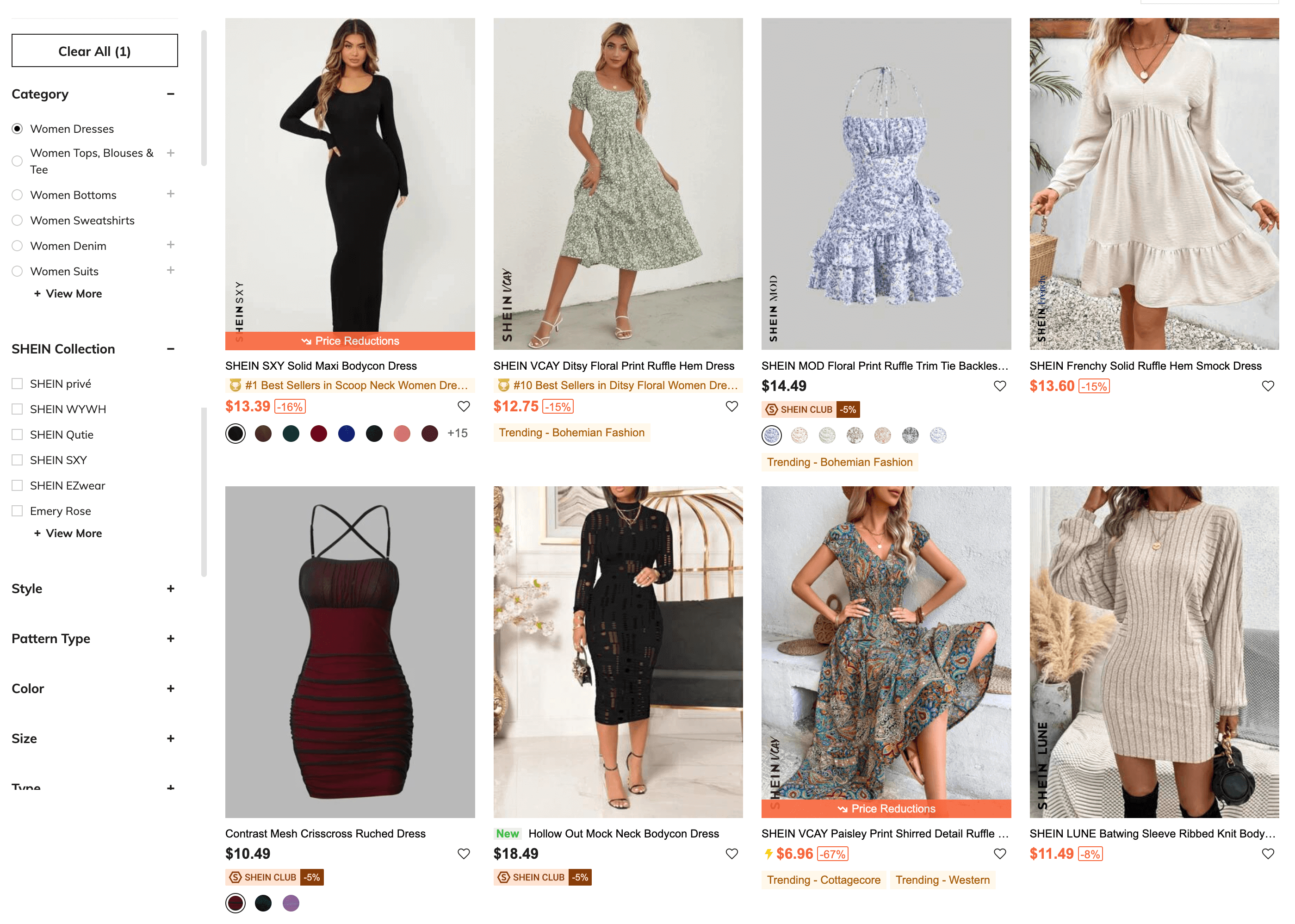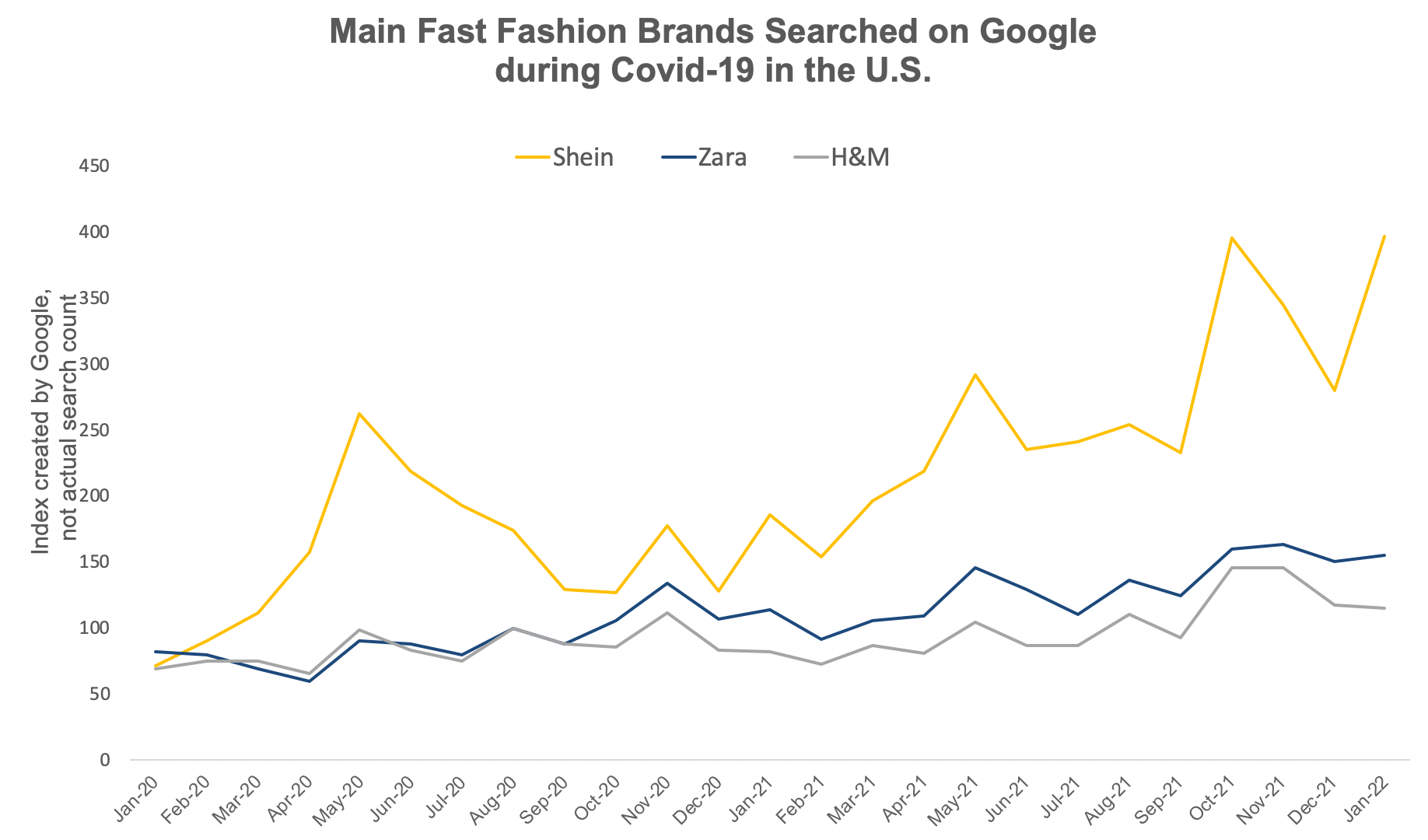Shein Revenue, Growth, Usage and Download Statistics for 2024
In this article, we’ll share all the key Shein statistics and facts you need to know about the fashion company that has quietly become one of the biggest names in online shopping in the world.
Read on to learn everything you need to know about Shein’s revenue, user base, product lines, activity and more.
Want weekly insights into how 7, 8 and 9-figure brands are driving sustainable growth? That's what you get with our value-packed newsletter, The Retention Edge. Subscribe for free today.
What is Shein?
Shein (pronounced “She In”) is an eCommerce company started by Chinese billionaire Chris Xu in 2008. The company originally sold wedding dresses, using the name SheInside before rebranding to Shein and switching focus to fast-fashion apparel in 2015.
Today Shein is an online-only fashion retailer, selling to customers in over 150 countries worldwide. They’re renowned for low prices, a huge selection of product lines and strong appeal with Gen Z shoppers.
Shein: Key Facts
- Founded in 2008 in Nanjing, China.
- Headquarters located in Singapore.
- Shein originally sourced products from wholesalers in a dropshipping-type model.
- Shein has since moved to become a fully integrated retailer, managing its own supply chain.
- Shein’s late-2022 investment round made the company the world’s largest fashion retailer.
- The company sells to over 150 countries, but does not sell to customers in its “home” country of China.
Learn more: Shein (and its closest competitor, Temu) relies heavily on mobile apps to keep users hooked and drive sustained revenue from repeat purchases. Check out this article to learn how they do it.
Shein Key Statistics for 2023
Let’s explore some more key statistics and facts you need to know about the Shein platform.
How Many People Use Shein?
As of the end of 2022, Shein has 65 million app users and approximately 74.7 million total users worldwide.
This represents significant growth over the past five years, leaping from 2.8 million users in 2017 to its current number.

Shein has approximately 13.7 million users in the US, again showing a significant rise from 490,000 users in 2017.

How Much is Shein Worth?
As of the end of 2022, Shein has a valuation of $100 billion.
This has increased from a valuation of $5 billion in 2019. The company received moderate investments in 2013, 2015 and 2018, before receiving $500 million in funding in 2019 and a further $1.5 billion in 2022.

Shein Annual Revenue
Shein made an estimated $24 billion in revenue in 2022.
This is a jump of nearly $8 billion versus 2021, having previously increased more than 3x from 2019 to 2020, increasing from $3.15 billion to $9.81 billion.

How Many Orders Does Shein Get a Day?
The exact number of orders Shein gets is not publicly known at this time. However, we can put together a rough estimate.
Shein’s average order value is $75, according to ChinaTalk. If they did $24 billion in revenue in 2022, we can estimate that they did 320 million orders over the year, which would equal roughly 880,000 orders per day.
For reference, Amazon ships approximately 1.6 million packages per day, putting Shein at a little over half the volume of the world’s eCommerce leader.
How Many Products Does Shein Sell?
Shein is estimated to have as many as 600,000 products for sale at any given time.
This number features significant turnover, with the company releasing over 300,000 new products every year. In comparison, H&M (another leading fast fashion retailer) releases approximately 4,500 new products per year.
Shein’s manufacturing rate is helped by the use of AI to analyze trends and create new designs, and over 3,000 suppliers working in partnership with the company.
Shein Brands
Like Amazon, Shein owns a number of private label brands. These brands are sold on both the Shein platform (alongside Shein branded clothing) and independent branded websites. Shein currently owns the following brands:
- MOTF: a “business-chic” clothing line providing high-quality professional clothing for women.
- ROMWE: “dark pop” pieces and social styles that have been seen on platforms like TikTok and Instagram.
- SHEGLAM: an affordable beauty and cosmetics brand.
- DAZY: a trendy streetwear label for both women and men.
- EMERY ROSE: a “cottagecore” style clothing line featuring smart-casual clothes for women.
- CUCCOO: a discount womens’ footwear brand.
- Luvlette: a womens’ underwear, lingerie and sleepwear brand.
- GLOWMODE: stylish and versatile activewear for women.
- PETSIN: a pet clothing and accessories brand.
- JMMO: tech devices and accessories.
How Many Countries is Shein Available In?
Shein is currently operating in over 150 countries, per their website.
How Many Employees Does Shein Have?
Shein employs nearly 10,000 workers worldwide, with 58% of Shein employees female and 42% male.
Shein Traffic Statistics
Shein.com reportedly receives 230 million visitors per month.
This puts their US website as the 107th most popular website worldwide, 92nd in the US, and the #1 website in the US in the Fashion and Apparel category.
Some other popular Fashion and Apparel websites get the following traffic numbers:
- Nike: 150.9M
- Zara: 82.3M
- ASOS: 66.3M
The average visitor spends 7 minutes and 24 seconds on the website and views over 8 pages per visit.
The majority of Shein’s traffic comes from organic search and direct, with search traffic making up 45.2% of Shein’s traffic, and direct traffic providing 38.3%.

Worldwide, the US is responsible for most of Shein’s web visitors, with 39.73% of their total users.
This is followed by Brazil, France, Spain and Canada.

Shein App Statistics
Shein’s mobile app is one of the most downloaded shopping apps in the world today. It currently ranks as the #2 app in the shopping category on both the App Store and Google Play.
The app generated more than 184 million downloads in 2022, nearly tripling its yearly downloads since 2019.

The peak for new downloads of the Shein app happened in May 2022, with 2.1 million iOS downloads and 920,000 Android downloads in a single month.
Similarweb estimates that the Shein app ranks 91st in all categories and 5th in the shopping category in the US in terms of usage rate.
If you're running an eCommerce store, and you don't have an app, you're missing out. Our eCommerce App Revenue Calculator shows just how much your brand can gain from launching your own app.
Why is Shein So Popular?
We know from the statistics above that Shein is now one of the biggest names in eCommerce, with one of the most popular shopping apps in the world.
So how did Shein go from a relatively unknown brand to the biggest fast fashion retailer in the world, surpassing the likes of H&M, Zara and ASOS?
Here are a few reasons why.
Low Cost
One of the first reasons we can look at is cost.
For a few reasons, such as their online-only business model (removing the overhead expense of managing physical stores) along with low-cost sourcing from Chinese manufacturers, Shein is able to offer products at ridiculously low prices.

The average product on Shein is reported to cost only $9. You can find quality products on Shein for less than half of what you’d generally pay from other retailers. This makes the platform extremely attractive to discount-hungry young shoppers.
Range
The platform also features a huge range of products, with over 600,000 styles available on the site, as mentioned earlier. Their business model and manufacturing connections allows them to constantly produce new products and outpace the competition in the fast fashion industry.
On-Demand Production
It’s not just the range of products they offer, it’s the fact that the product lines Shein sells are constantly turning over and always fresh.
Shein utilizes AI technology and a team of in-house designers to pump out new designs and try to get ahead of the latest trends. But the key thing is that they only produce 100-200 new pieces of each item at launch.
If it’s not popular, they don’t create any more. If a line does catch on, they can mass-produce it.
This allows them to offer an incredible range, with 500-2000 new products per day, without being bogged down by unsaleable inventory from product lines that don’t sell.
Pandemic eCommerce Boom
The pandemic undoubtedly played a big part in Shein’s rise as well.
Their user base nearly tripled from 2019 to 2020, then nearly tripled again in 2021, coinciding with eCommerce booming as most people were forced to stay home, and physical retailers were closed.
Google trends shows a steady increase in Shein’s search popularity over this time, significantly above competitors like Zara and H&M.

Gamification
Shein intensely pushes gamification tactics incentivizing users to spend more time shopping and buy more products on the site or the app.
This includes huge sales (sometimes as much as 80% off), first-time shopper discounts, discounts for downloading their app and reward points earned for buying products and contributing product reviews.

Social Influencers
Finally, and possibly one of the biggest reasons for Shein’s rise, is their social media presence and the social media influencers promoting the platform.
Shein is constantly being promoted on TikTok, with hashtags such as #shein and #sheinhaul generating billions of views.
In these posts, creators purchase sometimes as much as a thousand dollars worth of clothing from Shein to show off to their followers. These creators generally receive a commission for sales they refer from their posts.
The same goes on other social media platforms like YouTube and Instagram, and from independent fashion blogs.
This strategy has helped Shein take off with Gen Z shoppers in particular, who make up 50% of the retailer’s customers.
Push Notifications
Shein relies heavily on push notifications to drive user engagement.
As well as event-driven messages like abandoned cart notifications, Shein sends numerous messages to app users to try and entice them into the app to start shopping again.
It's not uncommon to receive 10+ notifications per day from the app, which does a great job of keeping the Shein app and brand top-of-mind.
Learn more about how brands like Shein and Temu use push notifications to drive engagement and build a regular shopping habit in this article.
The Future of Shein
Shein has already become one of the world’s biggest fashion retailers, with over 70 million active customers, over $20 billion in annual sales and nearly a million orders shipped per day.
The biggest threat to Shein’s further growth is controversy over their business practices, which some claim exploits low-paid factory workers in China. There’s also concern about the environmental impact of their ultra-fast fashion model, and the quality of the products they sell.
But with billions of dollars invested in the platform, Shein has the resources to improve in these areas and evolve into a more sustainable business (which their company website claims is an area of focus).
In 2023 the company also began opening up their platform to third-party sellers, testing this model in Brazil before expanding it to the US. So it appears the plan is to expand from a sole retailer to a marketplace akin to Amazon.
Whether they can truly challenge Amazon as the biggest name in eCommerce remains to be seen, but Shein’s popularity with young shoppers presents encouraging signs.
Sources
Daxue Consulting | Business of Apps | ChinaTalk | Business Insider | Wall Street Journal | Shein | Similarweb | Statista | Bloomberg
FAQs
Convert your website into a mobile app












